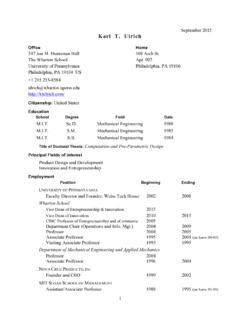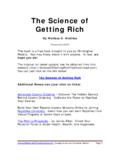Transcription of ProductDevelopmentDecisions: AReviewoftheLiterature
1 Product Development Decisions:A Review of the LiteratureV. Krishnan Karl T. UlrichThe University of Texas at Austin, CBA , Austin, Texas 78712 The Wharton School, 1317 Steinberg Hall-Dietrich Hall, Philadelphia, Pennsylvania paper is a review of research in product development, which we define as the trans-formation of a market opportunity into a product available for sale. Our review is broad,encompassing work in the academic fields of marketing, operations management, and engi-neering design. The value of this breadth is in conveying the shape of the entire researchlandscape. We focus on product development projects within a single firm. We also devoteour attention to the development of physical goods, although much of the work we describeapplies to products of all kinds. We look inside the black box of product development atthe fundamentaldecisionsthat are made by intention or default.
2 In doing so, we adopt theperspective of product development as a deliberate business process involving hundreds ofdecisions, many of which can be usefully supported by knowledge and tools. We contrastthis approach to prior reviews of the literature, which tend to examine the importance ofenvironmental and contextual variables, such as market growth rate, the competitive envi-ronment, or the level of top-management support.(Product Development Decisions; Survey; Literature Review)1. Introduction and ScopeThis paper is a review of research design and develop-ment. We define product development as the transfor-mation of a market opportunity and a set of assump-tions about product technology into a product avail-able for sale. Our review is deliberately broad, encom-passing work in the academic fields of marketing,operations management, and engineering design. Thevalue of this breadth is in conveying the shape of theentire research landscape.
3 The review is intended pri-marily for two audiences. First, we hope to benefitnew researchers entering the field of product devel-opment ( , doctoral students). We also hope thisreview will be valuable to experienced researcherswho are interested in learning about the range ofresearch in product development, perhaps to identifynew research opportunities or to locate issues thatintersect their current the broad scope, we limit the review in sev-eral ways. We focus on product development projectswithin a single firm. This focus is in contrast to muchof the literature on technological innovation, whichaddresses innovation at the level of an entire indus-try or an entire firm ( , Abernathy and Utterback1978, Utterback 1994). We also devote our attention tothe development of physical goods, although muchof the work we describe applies to products of allkinds. We focus on the academic literature, review-ing the practitioner literature only to the extent it hasbeen influential in the research community.
4 Finally,we focus ondecision makingin product development,as discussed in more detail in the next section. Thedecision-making focus excludes a substantial body ofresearch focused on the importance of environmen-tal and contextual variables, such as market growthrate, the competitive environment, or the level of0025-1909/01/4701/0001$ electronic ISSNM anagementScience 2001 INFORMSVol. 47, No. 1, January 2001 pp. 1 21 KRISHNAN AND ULRICHP roduct Development Decisions: A Review of the Literaturetop-management support. (For a review of this litera-ture, see Montoya-Weiss and Calantone 1994.)There have already been several excellent reviewarticles in the general area of product development(Shocker and Srinivasan 1979; Finger and Dixon1989a, 1989b; Whitney 1990; Cusumano and Nobeoka1992; Brown and Eisenhardt 1995; Griffin and Hauser1996; and Balachandra and Friar 1997). These comple-ment our efforts.
5 In areas where there is an excellentreview article, we do not provide a comprehensivesurvey of the literature, but rather cite the review. Wefound it challenging to keep the length of the papermanageable when attempting a review of disparatework from several different academic , we cite only archetypal papers when asubstantial amount of prior research exists in a partic-ular area. Our survey is by no means exhaustive, andis intended to serve as a pointer to this vast body ofliterature on product design and contribution in this paper is threefold. First,we provide a structured review of cross-functionalproduct development research with citations to overtwo hundred papers. We hope that this catalog helpsresearchers locate papers in new areas. Second, wepresent a parsimonious approach to organizing theproduct development literature using what we callthe decision perspective, which we develop in thenext section.
6 Third, we identify the current researchfrontier in product development research, offer a clus-ter of issues on this frontier, and discuss possibili-ties for future work that would extend the frontier inproductive directions. The rest of the paper is orga-nized as follows. Section 2 outlines our theoreticalapproach, including a conceptual framework contrast-ing the different functional perspectives of productdevelopment, and develops what we call thedecisionperspective. Sections 3 and 4 contain the bulk of thereview itself, with 3 covering development decisionsmade within a project, and 4 dealing with decisionsinvolved in setting up a project. In 5, we discusshow product development decision making relates tothe organization of academic research. Section 6 con-tains our concluding Theoretical ApproachOur approach to developing theory for this paper isinductive (Babbie 1995).
7 We base our theory, or sys-tematic generalizations of product development prac-tice, on both our observations of industrial productdevelopment and our review of the existing literature on product development isvast. To sharpen our understanding of the literature,it is useful to organize this literature into a few com-peting paradigms. Such a clustering is an attempton our part to elucidate differences, and may leadin some cases to an exaggeration of these perspec-tives. Indeed, we argue in this paper for a synthesis ofthese paradigms into thedecision perspectiveof prod-uct shown in Table 1, there are at least four com-mon perspectives in the design and developmentresearch community: marketing, organizations, engi-neering design, and operations management. In addi-tion to the dimensions highlighted in this table, theseperspectives often differ in the level of abstraction atwhich they study product development.
8 For instance,the organizational perspective is focused at a rela-tively aggregate level on the determinants of projectsuccess. (An excellent review of the large body ofpapers from the organizational perspective is Brownand Eisenhardt 1995.) On the other hand, much ofthe engineering and marketing literature is at a moredetailed level of abstraction, with the focus beingthe individual product engineer or market researcherand the issues confronting them. Finger and Dixon(1989a, 1989b) provide an excellent review of the engi-neering design literature, while a number of surveypapers have been published reviewing the marketingperspective (Green and Srinivasan 1990, Shocker andSrinivasan 1979, Mahajan and Wind 1992). Severalarticles have been published in recent years reflectingthe operations perspective, and some of them evenserve to bridge two or more perspectives. There hasbeen no comprehensive survey of these papers, andwe intend to fill this Decision FrameworkThere are significant differences among papers withineach of the perspectives we have identified, not onlyin the methodology used and assumptions made,2 ManagementScience/Vol.
9 47, No. 1, January 2001 KRISHNAN AND ULRICHP roduct Development Decisions: A Review of the LiteratureTable 1 Comparison of Perspectives of the Academic Communities in Marketing, Organizations, Engineering Design, and Operations ManagementMarketingOrganizationsEngineer ing DesignOperations ManagementPerspective onA product is a bundle ofA product is an artifactA product is a complexA product is a sequenceProductattributesresulting from anassembly of interactingof development and/ororganizational processcomponentsproduction processstepsTypical Fit with market Project success Form and function Efficiency PerformanceMarket ShareTechnical performanceTotal costMetricsConsumer utilityInnovativenessService level(Sometimes profits)(Sometimes direct cost)Lead timeCapacity utilizationDominantCustomer utility as aNo dominant flow diagramRepresentationalfunction of productOrganizational networkParametric models ofParametric models attributeProduct developmentProduct size, shape,Development processDecisionlevels, priceteam structure,configuration, function,sequence and scheduleVariablesincentivesdimensionsPoi nt of differentiationin production processCritical SuccessProduct positioningOrganizationalCreative concept andSupplier and materialFactorsand pricingalignmentconfigurationselectionCo llecting and meetingTeam characteristicsPerformanceDesign of productioncustomer needsoptimizationsequenceProject Managementbut also in the conceptualization of how productdevelopment is executed.
10 These differences reflect,in part, the enormous diversity of firms developingproducts, and it is difficult to develop a single theoryamidst such observe, however, that whilehowproducts aredeveloped differs not only across firms but withinthe same firm over time,whatis being decidedseems to remain fairly consistent at a certain level ofabstraction. To illustrate how decision at an aggregatelevel offer an opportunity to generalize, consider theexample of developing a product such as an ink-jetprinter. Some product development decisions include:Which (printing) technology will be adopted in the prod-uct? Where will the (printer) product be assembled? Whowill be on the product development team and who willlead the team? Which variants of the (printer) product willbe developed as part of the product family?Clearly, dif-ferent organizations will make different choices andmay use different methods, but all of them make deci-sions about a collection of issues such as the prod-uct concept, architecture, configuration, procurementand distribution arrangements, project schedule, the perspective that product developmentis a deliberate business process involving scores ofsuch generic decisions is what we call decision perspective helps us get a glimpseinside the black box of product development with-out being concerned about how these decisions aremade, and thereby offers an opportunity to general-ize and develop a grounded theory.








